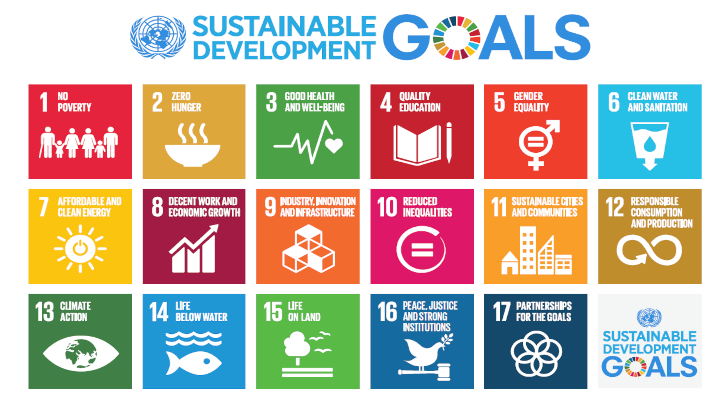Earth observation as a tool for monitoring Sustainable Development Goals

The Sustainable Development Goals (SDGs) must guide the implementation of the United Nations 2030 Agenda for Sustainable Development, adopted on 25th September 2015. The 17 SDGs are deployed in 169 targets to be achieved and 244 indicators to monitor their evolution. Topics covered include poverty, hunger, peace, health, education, inequality, inclusion, economic prosperity, the protection of the planet, the fight against climate change, cities and territories, and sustainable energy, consumption and production and governance. Earth observation, and its expression in the so-called Essential Variables, can be a valuable tool in the study and monitoring of some of the indicators of the evolution of the SDGs.
In recent years, researchers from different communities have increased their efforts to formalize a minimum set of Essential Variables (EVs) such as climate communities (GCOS for Essential Climate Variables - ECV), biodiversity (GEOBON for Essential Biodiversity Variables - EBV) or oceans (GOOS for Essential Variables of the Oceans - EOV). The definition of EVs is constantly evolving and is currently being introduced to other communities, such as in the field of continental water (EWV), although in most cases they are still in a very incipient state, as in the field of agriculture (EAV) or renewable energy (EREV).
Remote sensing and Geographic Information Systems (GIS) provide basic data and technologies for Earth observation (EO) and are critical to making decisions about the sustainable management of natural resources and addressing the threats of global change. EO does not provide any statistical indicators by default, but provides spatial, spectral, and temporal information that can be related to these indicators.
One way to explore the representativeness and understanding of a set of indicators is to use driver-pressure-state-impact-response (DPSIR) analysis. The DPSIR framework was developed by the European Environment Agency (EEA) and describes the interactions between society (anthropogenic activities), the environment (natural sciences) and the socio-economic consequences (social sciences). It proposes a categorization of indicators according to whether they measure the driver, pressure, state, impact or response of/to a given phenomenon. This classification has been used to classify the SDG monitoring indicators in this paper.
Within this study, the Research Group on Methods and Applications in Remote Sensing and Geographic Information Systems (GRUMETS) of the Autonomous University of Barcelona (UAB) and CREAF have identified, on one hand, the Earth observation networks providing data mainly at European level and thus create a graphical representation of their links. Additionally, this has been enriched with the EVs that could eventually be derived from data coming from EO networks. Finally, a link has been drawn between these EVs and the SDG indicators so they can also be indirectly connected to the Earth’s observation networks, thus closing the circle and creating a complete knowledge base. With all these links in hand, it has been possible to deploy an analysis in order to detect the existing gaps in the EVs due to the lack of observation networks and detect possible gaps in the indicators that should guide SDGs monitoring.
The framework of this study focuses only on the most stable variables and indicators today, i.e. ECVs and EBVs (climate and biodiversity). The full graph is available at http://www.eneon.net/graph-ev-sdg
The analysis of the data shows that the match between EVs and SDG indicators is far from perfect. On one hand, some SDGs are strongly oriented towards social or economic aspects, although social scientists have not yet adopted the schema of EVs. Additionally, even if there are EVs useful in tracking an indicator, they are ignored in the SDGs world. The UN and the GEO (Earth Observation Group) should work together to create new indicators, or adapt them, based on information provided by existing EVs. An example can be found in the indicators within SDG 15. Terrestrial life (Protect, restore and promote sustainable use of terrestrial ecosystems, sustainably manage forests, combat desertification, and halt and reverse land degradation and halt biodiversity loss) that could easily use additional information from some EBVs to have better, more accurate monitoring of this SDG 15. On the other hand, the set of indicators measuring human activities can rarely be related to EVs due to their socioeconomic nature which do not integrate EO data.
As a result, several suggestions are proposed in order to improve the definition of SDG indicators considering the existence of EVs, as well as the creation of new EVs and new indicators based on EO and not just in socioeconomic variables.
Joan Masó1, Ivette Serral2, Cristina Domingo-Marimon2 and Alaitz Zabala1
Universitat Autònoma de Barcelona.
1Grup de Recerca en Mètodes i Aplicacions en Teledetecció i Sistemes d'Informació Geogràfica (GRUMETS).
2CREAF, Ecological and Forestry Applications Research Centre.
References
Masó, Joan; Serral, Ivette; Domingo-Marimon, Cristina; Zabala Alaitz (2020) Earth observations for sustainable development goals monitoring based on essential variables and driver-pressure-state-impact-response indicators, International Journal of Digital Earth, 13:2, 217-235, DOI: 10.1080/17538947.2019.1576787.


